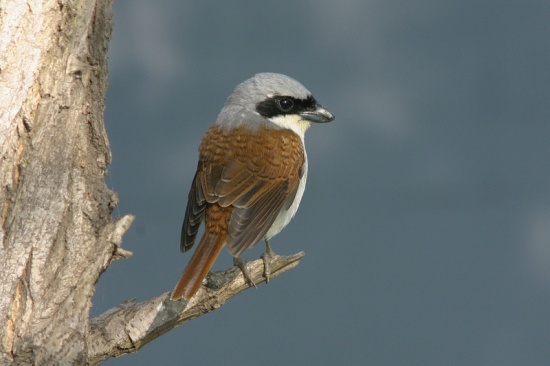(→Taxonomy: Update link) |
|||
| Line 1: | Line 1: | ||
[[Image:Tiger ShrikeJ.jpg|thumb|550px|right|Male<br />Photo by Jan Bisschop<br /> Happy Island, May 2005]] | [[Image:Tiger ShrikeJ.jpg|thumb|550px|right|Male<br />Photo by Jan Bisschop<br /> Happy Island, May 2005]] | ||
| − | [[Image:Tiger_Shrike.jpg|thumb|450px|right|Juvenile<br />Photo by | + | [[Image:Tiger_Shrike.jpg|thumb|450px|right|Juvenile<br />Photo by the late '''[http://www.birdforum.net/gallery/showgallery.php/ppuser/951/cat/500 Laurence Poh]'''<br /> Papan forest nursery, September 2003]] |
;[[: Category:Lanius|Lanius]] tigrinus | ;[[: Category:Lanius|Lanius]] tigrinus | ||
==Identification== | ==Identification== | ||
Revision as of 05:58, 28 July 2015
- Lanius tigrinus
Identification
17-19 cm
- Thick black-tipped blue-black bill
- Greyish-black legs
- Reddish brown back, rump and shoulders with black bars creating a tiger-like pattern
- Black mask
- Grey crown and nape
- Dull brown wings and tail
- White underparts
Female: duller with white stripe above the eye and black barring on the flanks
Young birds have dark scale-like markings and lack the grey and black head markings
Distribution
Central and eastern China, Korea, Japan, far east Russia. It winters mainly in Malaysia and Indonesia.
Taxonomy
This is a monotypic species[1].
Habitat
Lowland forests and forest clearings and edges, cultivated land, rice fields, mangroves and gardens
Behaviour
Diet
The diet includes grasshoppers, crickets, beetles, bugs, butterflies and moths. Other small animals including birds and lizards are also taken. It usually hunts from a perch at the forest edge.
Breeding
Both adults build the nest on a branch in a deciduous tree. The clutch consists of 3-6 eggs (usually 5) which the female incubates for 14-16 days. The young fledge around two weeks later, staying close to the nest for a further two weeks.
References
- Clements, JF. 2011. The Clements Checklist of Birds of the World. 6th ed., with updates to August 2011. Ithaca: Cornell Univ. Press. ISBN 978-0801445019. Spreadsheet available at http://www.birds.cornell.edu/clementschecklist/downloadable-clements-checklist
- Wikipedia
- BF Member observations
Recommended Citation
- BirdForum Opus contributors. (2024) Tiger Shrike. In: BirdForum, the forum for wild birds and birding. Retrieved 18 April 2024 from https://www.birdforum.net/opus/Tiger_Shrike
External Links





